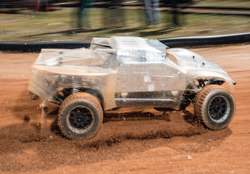|
Audi’s research car, the Audi A7 piloted driving concept,
internally nicknamed Jack, is now driving more naturally. Jack knows how to
autonomously perform all of its driving maneuvers on the expressway and has now
learned how to show consideration for other road users by adapting its driving
style to the situation at hand.
To this end, Jack now passes trucks with a slightly wider
lateral gap. It also signals upcoming lane changes by activating the turn
signal and moving closer to the lane marking first, much like human drivers
would do to indicate their intentions. The cooperative attitude of Jack is
especially apparent when other vehicles want to merge into the lane, such as on
an expressway.
Based on the selected driving profile, the test car decides
whether to accelerate or brake, depending on which is best suited to handling
the traffic situation harmoniously for all road users. Upon request, the
navigation system can also compute a route with the largest proportion of
piloted driving sections.
Autonomous driving offers greater safety, more efficient
utilization of the transportation infrastructure, and more relaxation time for
the driver. Audi has derived systems for assisted driving from the tested
technologies and is currently offering production car technologies such as the
function for assisted driving in traffic jams in the Audi A4 and Audi Q7.
 At the Georgia Tech Autonomous Racing Facility, researchers
are studying a one-fifth-scale electric-powered autonomous vehicle as it
traverses a dirt track at the equivalent of 90 mi/h (145 km/h). This will help
the engineers understand how to program driverless vehicles to handle the risky
and unusual road conditions of the real world. At the Georgia Tech Autonomous Racing Facility, researchers
are studying a one-fifth-scale electric-powered autonomous vehicle as it
traverses a dirt track at the equivalent of 90 mi/h (145 km/h). This will help
the engineers understand how to program driverless vehicles to handle the risky
and unusual road conditions of the real world.
The AutoRally cars use onboard computing and installed
sensing devices for stochastic trajectory optimization to increase vehicular
stability while maintaining performance. The Georgia Tech method, known as
model predictive path integral control (MPPI), works together with the
high-power graphics processing unit (GPU) that the vehicle carries. The MPPI
control algorithm continuously samples data coming from global positioning
system (GPS) hardware, inertial motion sensors, and other sensors. The onboard
hardware-software system performs runtime analysis of a vast number of possible
trajectories and relays decisions to the vehicle moment by moment.
In essence, the MPPI approach combines both the planning and
execution of optimized handling decisions into a single, highly efficient
phase. It is regarded as the first technology to carry out this computationally
demanding task; in the past, optimal-control data inputs could not be processed
during runtime. The onboard GPU lets the MPPI algorithm sample more than 2,500
2.5-s-long trajectories in under 1/60 of a second.
Full article: IEEE
Vehicular Technology Magazine, Volume 11, Number 3, September 2016 |